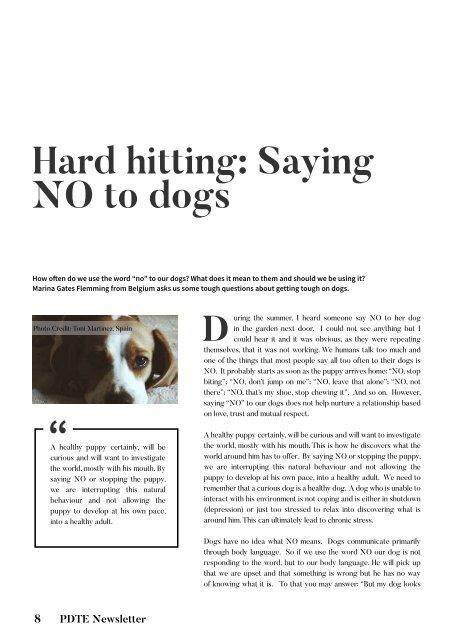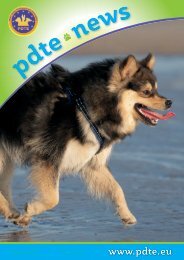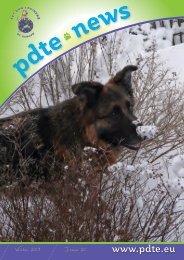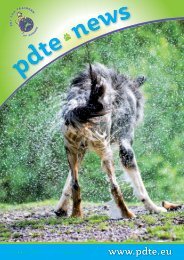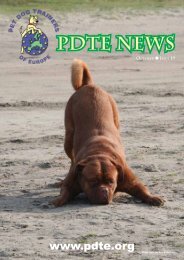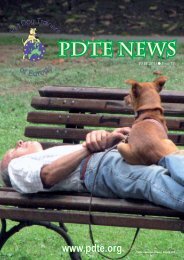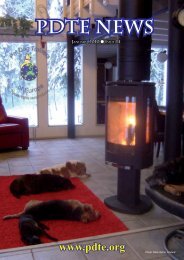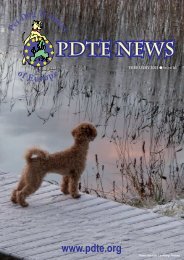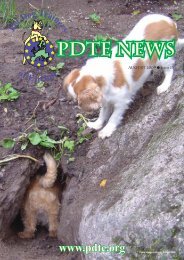PDTE 2016 July Newsletter
You also want an ePaper? Increase the reach of your titles
YUMPU automatically turns print PDFs into web optimized ePapers that Google loves.
Hard hitting: Saying<br />
NO to dogs<br />
guilty, he must know what he has<br />
done”. Actually, our dog is simply<br />
responding to our “threatening” body<br />
language and communicating in the<br />
only way he knows how to.<br />
Dogs are dogs and they do dog stuff:<br />
chewing, digging, peeing, barking,<br />
nipping, etc. This is all normal<br />
behaviour for dogs, but unfortunately<br />
for them we have a tendency to dislike<br />
these behaviours. So we start saying<br />
NO without even realizing it. At first,<br />
because to him, these behaviours are<br />
normal, our dog becomes confused;<br />
then frustration sets in on both<br />
sides. This can lead to stress further<br />
damaging the desired relationship.<br />
when we say NO. If the dog is doing something we do not wish him to do, instead<br />
of shouting NO, let’s offer him an alternative:<br />
If our dog is jumping up on us, let’s keep turning away from him, without speaking<br />
to him or making eye contact, whilst giving the hand signal thereby giving him a<br />
clear message that now is not the time for any interaction.<br />
If our dog has run off with our toddler’s shoe, let’s invite him to back to us,<br />
offer him a reward for coming and giving us the shoe back and then offer him<br />
something he is allowed to play with. Remember it is our fault not his that he has<br />
the shoe in the first place.<br />
If our dog is barking at the fence/front door, let’s thank him for letting us<br />
know, then show him that there is nothing to worry about and take over the<br />
responsibility, allowing him to take himself off without a care in the world.<br />
How often do we use the word “no” to our dogs? What does it mean to them and should we be using it?<br />
Marina Gates Flemming from Belgium asks us some tough questions about getting tough on dogs.<br />
Photo Credit: Toni Martinez, Spain<br />
“<br />
A healthy puppy certainly, will be<br />
curious and will want to investigate<br />
the world, mostly with his mouth. By<br />
saying NO or stopping the puppy,<br />
we are interrupting this natural<br />
behaviour and not allowing the<br />
puppy to develop at his own pace,<br />
into a healthy adult.<br />
During the summer, I heard someone say NO to her dog<br />
in the garden next door. I could not see anything but I<br />
could hear it and it was obvious, as they were repeating<br />
themselves, that it was not working. We humans talk too much and<br />
one of the things that most people say all too often to their dogs is<br />
NO. It probably starts as soon as the puppy arrives home: “NO, stop<br />
biting”; “NO, don’t jump on me”; “NO, leave that alone”; “NO, not<br />
there”; “NO, that’s my shoe, stop chewing it”. And so on. However,<br />
saying “NO” to our dogs does not help nurture a relationship based<br />
on love, trust and mutual respect.<br />
A healthy puppy certainly, will be curious and will want to investigate<br />
the world, mostly with his mouth. This is how he discovers what the<br />
world around him has to offer. By saying NO or stopping the puppy,<br />
we are interrupting this natural behaviour and not allowing the<br />
puppy to develop at his own pace, into a healthy adult. We need to<br />
remember that a curious dog is a healthy dog. A dog who is unable to<br />
interact with his environment is not coping and is either in shutdown<br />
(depression) or just too stressed to relax into discovering what is<br />
around him. This can ultimately lead to chronic stress.<br />
Dogs have no idea what NO means. Dogs communicate primarily<br />
through body language. So if we use the word NO our dog is not<br />
responding to the word, but to our body language. He will pick up<br />
that we are upset and that something is wrong but he has no way<br />
of knowing what it is. To that you may answer: “But my dog looks<br />
We probably say NO in many<br />
different situations and the dog has<br />
no idea which action the NO applies<br />
to. How can our dog understand that<br />
NO means stop jumping up in one<br />
instance, stop nipping in another and<br />
don’t chase the neighbour’s cat in yet<br />
another. NO is said so very many<br />
times that dogs simply do not even<br />
hear it any more*.<br />
This apart, we could also be giving<br />
our dog attention and therefore<br />
reinforcing that behaviour because<br />
attention, even if negative, as in a NO,<br />
is still attention and can therefore be<br />
reinforcing to the dog especially if that<br />
is what he was seeking.<br />
Worse still, we may not realise this,<br />
but by saying NO, we are actually<br />
punishing our dog and this can be<br />
very disruptive to our dog’s wellbeing.<br />
Indeed, our dog needs to feel<br />
safe when with us, so in addition to<br />
being ineffective in changing the<br />
“unwanted behaviour”, it disrupts the<br />
bond between us. The inconstancy<br />
caused by the NO will result in our<br />
dog to feeling a lack of safety with us,<br />
instead of feeling happy and confident<br />
in our relationship.<br />
We are not teaching our dog anything<br />
Photo Credit: Winkie Spiers, UK<br />
Saying NO is a bad habit, which is best not acquired. If acquired it’s wise to work<br />
hard at losing it as quickly as possible as it will not benefit our relationship with<br />
our four legged friend.<br />
* In psychology, this is called “Learned Irrelevance”, the dog is not able to link a consequence<br />
to the sound and therefore decides it has no relevance to him and systematically learns to<br />
ignore it (this happens all too often with “recall” as well).<br />
8<br />
<strong>PDTE</strong> <strong>Newsletter</strong> <strong>PDTE</strong> <strong>Newsletter</strong> 9


